- “Sokerissa!” is a dance group in which homeless people perform as the dancers. I have seen their performances several times and I found the sheer presence of their bodies imprinted with the hardships of living on the streets to be extremely powerful. You personally have never experienced living on the streets, and you have said in the past that you are not creating works to show the struggle of the homeless.
- Yes. What I want to show through these works is “living bodies” that only these people can show. We take for granted a life where we have money, we can eat every day and we have a place to sleep. I wanted to show not dance that comes from the bodies of people that live normally in such an environment, but [movement that comes from] the bodies of people that have to struggle day by day just to stay alive. And, in that sense, the bodies that are the most alive of any, right now in this country, Japan.
- But, what motivated you to create dance with these homeless people in the first place?
-
Around 2004, there was a live performance by a young band on the street in Shinjuku, and right nearby there was a homeless man sleeping on the sidewalk with his pants down and his butt sticking out. Of course there was a big crowd of people around the band, but no one would stand near the sleeping man. You could say that this was not an uncommon scene, but it made a very strong and thought-provoking impression on me. More than anything, I thought it was amazing that a man could lie there like that with his butt sticking out and not care about being seen like that. It made me think what it would be like if a person like him was to perform in front of an audience. I felt certain that it would show a world that I had never seen before. At first, I thought about things like what would happen if I could teach dance to homeless people, but I soon realized that anything I could do would never compare with the awesome presence of the homeless body if I was standing in front of them [to teach]. So, I decided to just try to dance with them, but then, that idea presented me with the fundamental question of what my presence would be in such a creative process.
Getting beyond 9.11
- Would you tell us about your personal background before starting Sokerissa!? When did you begin dance?
-
I am from Kobe, and I played basketball throughout my high school years, but out of admiration for Michael Jackson and the movie
Break Dance
I started teaching myself dance. Three days after I graduated from high school I decided to make my living in dance, and with no connections or anything, I took off and moved to Tokyo. When I got here I happened to see an advertisement in the newspaper by a theater company soliciting applicants for its training course for young talents (laughs), and there I studied acting and jazz dance. The work went well and before two years were up I got work in things like dancing at a major theme park and as a back-dancer for young “idol” groups, so I was fortunate to be making a comfortable living. I didn’t have any particular teacher at that time and I was doing primarily jazz dance and street dance. Then in 2001, I wanted to study dance overseas, so I went to New York.
- Were you there during the 9.11 terror attacks in 2001?
- Yes. It was a really shocking experience for me. It gave me the same kind of feelings that the Great East Japan Earthquake and Tsunami did. It made me feel how self-centered my approach to dance had been until then and that it didn’t provide any help to anyone else in the world; I felt I was just copying things that I thought looked cool. I wondered what I had been looking for until then and made me think seriously about ways that I could make more of a commitment to the world.
After returning to Japan, I first of all signed up with a [dance promotion] agency, so that I could get settled and begin to think about what I was going to do. The agency’s name was Office LOU and Kaiji Moriyama was one of the dancers there. While I was working there, I went to a lot of contemporary dance and Butoh performances and took part in workshops.- Who did you study Butoh under?
- It was Akira Kasai. Studying with him, I felt a very strong identity as Japanese, and what I learned about how to look at and think about yourself and your state as a person/dancer connects strongly to my sense of dance today. At that I time I was simply trying to watch and expose myself to as much dance as possible, and among the things I saw, I was especially impressed by the system and style of the company Noism. And, it was at that time when I was searching for something that I encountered the homeless man sleeping on the sidewalk with his butt sticking out.
Days of trying to get the homeless to dance
- But, I would imagine that very few homeless would listen to you if asked them if they wanted to do dance.
- That’s right. I went scouting for candidates on the streets of the Tokyo districts of Shinjuku and Ueno, but I am not a very persuasive talker to begin with, so I first just watched from the shadows looking for one that seemed like they might listen to what I had to say. When I found someone who looked like he might listen, I would spend a few days getting on friendly terms, but when I would finally get to the point and say that I was looking for people to do dance with, that would say, “What are you talking about?” and not even consider taking it any further. But I kept trying, repeating the same approach again and again in different places for about half a year.
- Did you ever reach a point where you thought the idea was hopeless?
-
People around me repeatedly said that it was hopeless, but I was certain that working with these homeless men on a dance project was exactly the direction that I wanted to pursue, so I couldn’t give up the idea. Eventually, someone introduced me to the Japanese branch of Big Issue (An organization that sells its Big Issue magazine to raise money to aid in homeless returning to a normal life in society. It originated in London and now has branches around the world). The president of the Japan branch of Big Issue took an interested in my project and he invited me to come to one of the meetings where the people who sell the magazine (called a “salon” meeting) so I could talk to the homeless that gathered there about what I wanted to do.
- The homeless coming to such a meeting must be ones with a relatively high level of social activity, didn’t they? Did any say they would join your project?
- No, it didn’t work (laughs). When it got to this point, I realized that the only way I was going to get anyone interested in trying would be to get them to see the kind of dance I had in mind. So, I went around telling all the homeless I could that if they came to a certain place at a certain time, they could see what kind of dance it was, and I asked them to just come and check it out once. When the time came, five of six actually showed up, and I performed my dance them. I explained to them that this was not the kind of dance that used professional technique but a kind of dance where you take movement from everyday life and used it to bring out the things inside you. And then, I told them that this was what I really wanted to do together with them! Hearing that, all of them said, “OK, we’ll do it.” That was in 2007.
- At that point in your career, did you have any experience creating your own dance pieces?
- Just after I came back to Japan from studying in New York, I won the Grand Prize in the dance festival called NEXTREAM. It was a relatively nice, refined piece performed by me and two other dancers and a young violinist.
The body facing the challenge of survival
- But with the homeless, whose lives are consumed with the struggle to live day to day, wasn’t it difficult to get them to come to practice and rehearse?
- Big Issue gave me funding for food and transportation for the participants, and after each practice session we would all eat a meal of rice balls together, and my feeling was that it was fine if some of them came just to get the meal after practice. The space we used was a studio at the agency I belonged to, which they lent us time at for free. But, since the homeless can’t take baths, it naturally got pretty smelly. At first I lent them training wear facility, and even if I gave them a change of socks, I couldn’t very well give them all a change of shoes. In those conditions things got smelly very fast. But, that is the kind of “organic” feeling I wanted, so I thought, “This is the real smell of human beings!” So, I was in there getting as smelly as them during the lessons.
- What kinds of things did you do with them in the lessons initially?
-
With many of the [homeless] people they had muscle atrophy and their bodies were quite stiff, so we began by doing a lot of stretching, for about an hour and a half. Then I tried having them move their bodies in a variety of ways. It wasn’t much more at first than having them just walk, or raising their arms a bit. Initially, I was thinking of choreographing something for them to do, and I had them learning to do some choreographed movements I had thought up, but then they would forget the movements in no time at all (laughs). Also, there was nothing interesting about just having them do movements I had thought up. On the other hand, I found that the movements they came up with little by little by thinking out things by themselves turned out to be fascinating. They came up with lots of movements I could never have imagines myself, so I decided that bringing out and making use of these movements should be my top priority. That led me to begin basing the choreography on “words” rather than [learned] steps.
- What did basing choreography on words involve?
- If I thought that one of the men had an interesting way of walking, I would give him a [verbal] image by saying something like, “Try walking as if you were walking on the Moon.” If you think that image would lead the person to walk with light, floating steps, that is not how it turned out with him. Because he had an interesting way of walking to begin with, what came out when given that image was completely unexpected movement. Also, since it was movement that that person had come up with himself, he took the responsibility to remember it and memorize it as well.
This “man with the interesting walk” was one of the men participating in the lessons and rehearsals our first Sokerissa! performance, and he was a person who really liked to walk. When I gave him verbal images like “go forward into the future, go back into the past,” I would have imagined that he would start walking back and forth vaguely, but what he actually did was to start walking in place without leaving the same spot (laughs). That really impressed on me with the feeling that the world he has seen and the things he believes in and his perceptions of things are really different from what I am used to.- For your first Sokerissa! performance in 2007 you used the group name “Shinjin H” and Sokerissa! was actually the name of the piece your group performed, wasn’t it?
- That’s right. The H of “Shinjin H” stood for Home and also for Human, and the term shinjin (new person, rookie, novice) I used with the idea that this was a group that are novices in dance and also with that this was a group that wanted to move forward as “human beings with new values.” The word “Sokerissa!” was something I made up to express the vitality and momentum of the Japanese term sore ike ! (Let’s go! or Let’s do it!). I originally intended it as the title of the piece we were going to perform, but everyone developed such an attachment to the term that we changed our group name to “Shinjin H Sokerissa!”
Sokerissa! was a pieced that sought to depict the human race around the time when human first started to use words, and it was composed with the “man with the interesting walk” as the main character. But, one week before the performance was scheduled to take place, we lost contact with him and he never showed up for the performance. So, I had to take his place and perform his part in the piece in our debut performance.
Not showing up for performances can’t be helped
- So, he never showed up for the performance in front of the audience!
- I heard later that he walked all the way to Enoshima (approx. 60 km from central Tokyo) to see the dolphins (laughs). Because, he is a person who really liked to walk. To him, I think that walking wasn’t just a means of getting from one place to another or a way to keep healthy. Probably, for him walking was the equivalent of being alive. I think that walking to a destination must have given him something that you wouldn’t get from making the same trip by train. I suspect that he was always living and feeling in the here and now, and that may be why he started walking in place when I said, “go forward into the future, go back into the past.” He made me think about a lot of things of this sort. Eventually, he walked back to his hometown in Fukushima Prefecture, but I feel that I have really gained a lot from knowing him and the other [homeless] men.
- Having people suddenly disappearing and never knowing if someone is going to show up on the day of a performance or not certainly represents a big risk for someone like you who is trying to create productions for performance, isn’t it?
-
I try to get the participants to be discipline with regard to our activities by making sure they know that each week we will get together to practice on a certain day of the week at a certain time, and making sure that there are ways that we can always get in contact with them, but at the same time I am doing it all with the understanding that the worst-case scenario can happen and someone won’t show up on performance day. For our second Sokerissa! performance (2008) we prepared a piece titled “Iikagen na Uta no Sho” (A poorly-wrought song chapter). There was one man in the group that year that really loved to sing, and I composed the piece around him. He loved singing, but technically he was a very bad singer and he had lost most of his teeth, so his voice came out with not much more than a whistling sound (laughs), but it was really endearing. Usually he sang about everyday scenes from his live as a homeless on the streets of Shinjuku as he danced, but in the piece I was going to have him do it to orchestra music in the midst of a paper snow flurry we created using four fans.Although this may be a contradiction of what I said at the beginning of this interview, for once I wanted to do a piece that was clearly about the conditions of [homeless] life on the streets. But, it was difficult because the men couldn’t say their parts well in the wind and paper snow flurry, and false teeth kept falling out, for example, but the way they stood to face the difficulties was very dynamic. In fact, this was another case where the main character, in this case the man that loved to sing, stopped coming to rehearsals before the performance, so we ended all doing his part together in the performance.
- Another no-show case! (Laughs)
- Our next performance was of a piece titled “Zenchi, Zenno” (2010). One of the men taking part in our practice sessions that year had a gender identity disorder, so I decided to do a piece on the theme of “People seek perfection.” He was an honest-looking man with thinning hair, but he was slender and wore pink clothes with a skirt so tight that he couldn’t spread his legs when we did our stretches. In his mind, he was completely a woman. I thought, “OK. In the performance we are going to make this man incredibly beautiful.” I was going to put clothes and lipstick on the stage and have him dress and do his makeup so that in the end he would be completely transformed into a woman. Woman means mother, and the biggest presence of all.” But again, the guy stopped coming to the rehearsals. (Laughs)
- Can’t you be firm and tell them that they definitely have to show up at least for the performance?
- The fact that there are some who like alcohol and some who like gambling, etc., is what makes them a group with such rich variety. And, since I want to place importance on these men’s sensibilities and perceptions, I never say anything to them about their personal everyday lives. I don’t think it is up to me to say this is good and that is bad, based on my own perspective. That means that those who don’t come to practice will have fewer opportunities to appear on stage, but if they don’t want to be on stage, there is nothing we can do about that, I believe.
- I see. That means that you really have to be prepared to accept the worst when it happens, doesn’t it? (Laughs) Your group performed in the 2011 Ono Kazuo Festival. That is when you drew the attention of a lot of people in the dance world.
- There we performed a piece titled “Shinsekai Waltz” (New World Waltz). It was based on the thought that if the human race were to make a new planet and began living there, would it become the same kind of world we have now? We put fire and water and soil on the stage to make a planet. It was also the story of a family, with Yokouchi-san as the Mother, the taller Koiso-san as the Father and Ito-san as the Child. They also invited us to perform at the 2013 Ono festival, and that time we performed a piece titled “Tsuno-hito” (horn people). It was based on the idea that animals have weapons in their fangs and horns and claws, so what would it be like if human beings had horns as their weapon.
You could say that the fundamental concept behind all of these pieces is the same: basically, we are interested in people and we want to know what the essential nature of human beings is.
Dance born of the essential necessities of movement and form
- Since the 1980’s, when the term contemporary dance itself first came to be used, we have often heard statements like, “the body of a non-dancer is more interesting than the body of a dancer.” I wouldn’t negate that idea as it is, but it is very hard to create an hour-long work with just interesting movement. It seems to me that it is very risky to attempt to do that.
- Yes. Since the [homeless] men are already starting from essentially nothing, and I think that made it easier in some aspects to take on that challenge without concern about failure. The important thing is not that I simply let them dance and act as the director but that I have the strong desire and will to dance with them. For example, when one of the men makes an unexpected move, I have to immediately accept it and improvise around it. If one of the men has stopped moving and is just standing there when it is a scene where he has to perform an important part, new meaning will be born if I go out, stand beside him and look at him intently [until he begins to move]. My hope is that I, with my unworthy skills, can bring together the pieces—including the clumsy, hurry-scurry parts—into something that will stand as a work of dance.
- Are there some areas where, conversely, you as a dancer are being influence by the [homeless] men in the group?
- There are, but even if I tried to imitate [their movement], I could never match their powerful presence (laughs). So, what I am constantly training myself to do is to keep my senses sharp so that, no matter what happens, I can take it in and react positively to it. And, there are some people who, watching me on stage, project themselves into my position and imagine they are interacting with the [homeless] men. Personally, when I am in that space I want to be a presence that is not human, something that is different from a human being in some way, but from the perspective of some [in the audience] I am also expected to be present there as a human being.
- Have the [homeless] dancers changed in the course of the group’s activities?
-
They are completely different from when we started out. At first there was a sense that they were alienated from the rest of society, but now they smile and laugh and show a richer range of emotions, and they have become more positive about themselves. Any person would be pleased when people appreciate the movements that they had created by themselves, and this feeling may be even stronger in these [homeless] men. Before a performance they are all nervous. They have a strong feeling that this is the time when they must show well the things they have created and learned, and so they become quiet in the moments before a performance. They do their stretches quietly and diligently, and after the performance is over they go around to properly say a word of thanks to everyone involved. It is obvious that they have a clear understanding and appreciation of the fact that the audience has come to see them. In fact, all of them even go to see other people’s dance performances fairly regularly as well. But, whatever kind of dance performance they see, you will never hear them saying negative things about other people’s dance. And, they are positive about the act of dance itself. Doing dance is a very rewarding part of their lives for them, and it seems to me that that dance grows within them as something good in their lives.
- If you are presenting something as a work of dance [art], a certain level of quality is necessary. In the historical context, dance or gymnastic exercise are also disciplines in one aspect. Under the instruction of a teacher, dancers train their bodies. Normally, the most obvious way to raise the quality of the pieces would be for you, the experienced dance artist, to “choreograph” the movement of the dancers (which would in effect also be forcing them to perform specific movements), but your method apparently does the opposite. So, how to go about raising the quality of your group’s works?
- Certainly, in something like jazz dance where the movements are clearly defined, it is probably best to give the dancers choreographed movements one after another. But, we should also be trying to create new movements one after another, and in that context I feel that one of the valid types of movement is movement that can only be created by each individual and no one else. I feel that potential to create unique individual movement in these [homeless] men. If one of them falls asleep during a performance, your decision of whether to get the person off the stage of to leave him sleeping there and show it as an amazing development, will change the impression and impact that the piece takes on. It is a decision of whether or not to make use of their good, unique qualities and flavor.
Their ability to concentrate is increasing with each stage, and every time the performances produce amazing powerful things from these men’s bodies. However, since it is not [choreographed] movement that is forced on them, we come to see form and movement that is consistent with the nature of their individual bodies. The quality of our pieces becomes a matter of how successful we are in bringing out and heighten this kind of “form and movement born of essential necessity,” and I believe that job is my responsibility.- “Form and movement born of essential necessity” is an interesting concept.
- I imagine that is probably the way dance originally developed. I think that when ballet was first being created, it was a process of accumulation the forms that emerged from the creators studies of beauty of form and movement. However, today the trend is to begin with the forms that have become convention and then pursue expression within that framework. But, as in the case of the movements of hip-hop that emerged within a context of rebellious opposition to being alienated from society, I feel that the process of creating new forms from that context is also important. I sense a similar atmosphere or scent when I watch the movement of our [homeless] men.
- So is it dance born of the rebellion of “bodies alienated by society”?
- But, to be honest, the motivations of the men who come to dance with us vary significantly. Some come for the rice balls we eat afterwards, some in order to connect to other people, some to relieve stress, and some as a way to keep healthy. But, that is all fine. I personally have aims for us as a dance company, but there is no need for all of our men to work together toward common aims. On the contrary, it is important that we all work together, but each of us toward our own individual and separate goals.
I can say this because I am not a social worker, but I know that many of these [homeless] men don’t want to get back into society. More than a few have the feeling that they like living on the streets because it is a free and easy to live and they have their group of friends there. And, living as a responsible member of society has its stresses. Sleeping in cramped quarters can make your body crooked, but some say that sleeping on hard surfaces makes shoulders less tense, or that because of the lack of stress they aren’t losing their hair. In fact, there are actually some of these men who have quite loose (not stiff) muscles.- But, don’t some people look on you as a kind of social activist?
- I heard that a lot in the beginning, it’s true. But, those people turned away when they learned that what I want to do is art, not social work (laughs). There are probably a lot of people who don’t think art can do much good for society. However, art is a means to propose new values, and I believe that from olden times art must have been one of the forces that has helped change the world. Rather than acting on principles, I believe that continuing to present things more abstractly, as art, can communicate more about qualities and people’s thoughts.
Experiencing the Caste system in India
- Are there any things that you want to do in the future?
-
In 2008, I went to India to do some research in preparation for someday taking our homeless men there. Since I had no connections there, I asked people at a Japanese school there and got an introduction to a people at an Indian international exchange foundation so I could ask them if there was any place where I could do dance on the streets. The place they told me to go was a street beside a mosque in a section of Old Delhi, which is a place where people of the lower Castes under the Caste system (which was officially abolished in 1950 but is still strongly rooted in Hindi society) used to gather. There I went and danced alone, using cardboard covered with paper that I painted things like waves and faces on. After about 10 or 15 minutes, a crowd had gathered around me, and it gave me confidence that I could get some of them to join me. So, I gave one of the men in the audience a piece of paper and said, “You can do it too. Why don’t you try.” But then suddenly his expression changed and he tore up the paper, threw it back and then got mad, and the other people around him joined in a said angry words at me too.
- That was an unexpected response, wasn’t it?
- I didn’t know what was happening. Later, when I asked my guide, he said, “Those people feel that they can’t escape from their [low] Caste for their entire lives. So, they forbid themselves to trying new things or having creative feelings, and that must be why they got confused and angry.” It was a real shock to me when the man tore up the paper and it brought me to tears as I was walking back. I felt helpless, and aware that there was still so much that I didn’t know. It was a very good experience for me to have.
- Perhaps they are convinced that showing the desire improve one’s lot will draw criticism as someone trying to disrupt the Caste system.
- Perhaps that may be. After that, I switched to only showing my own dance and went around to several locations in India performing. Since I am Japanese and was doing a kind of dance they had not seen before, lots of people gave me a variety of opinions about my performances. Although a lot happened on that trip, positive and negative, I still want to take our [homeless] men to India. I am anxious to see how people there will view them and what our men will feel there. But, there is still a lot that I personally have to learn before I can take on that challenge and not have it end purely as a project conducted completely from the Japanese perspective.
In search of the primal body
- I hope this doesn’t sound offensive as a question, but it seems to me that there may be some people who have trouble with the idea that you, having never personally experienced [homeless] life on the streets and having already achieved a degree of financial and social success, should take homeless men as the objects of your dance activities.
-
Yes. It is true that one aspect of Sokerissa! is that it shows the bodies of men who have lived on the streets as homeless, and I understand that for that reason it takes on a social meaning, whether I want it to or not. But, the thing I want to see above all else is human bodies dancing as they would have in pre-historic (primeval) times. It is the desire to see the movement of bodies in a life where every action of the body is connected to the process of daily survival (living). And, I cannot deny that I found an example of that type of body in the contemporary world in the [homeless] men who live on the streets and that some people will say that I am using them to realize that form of expression I am seeking. And, I cannot deny that I found an example of that type of body in the contemporary world in the [homeless] men who live on the streets and that it may be true if people say that I am using them to realize that form of physical (and artistic) expression I am seeking. However, there is also definitely a realm of physical expression that can only be shown by bodies that have lived [and survived] on the streets. And, for these men to be appreciated for that type of expression is also something that gives them tangible appreciation of the fact that they are able to live because of the society around them. And, that may be something that gives vital energy to other homeless and other socially disadvantaged people. These are all things that I am thinking about as I work together with my group. If this stance of mine doesn’t show through and if people say I am merely making a spectacle of these men, there is nothing I can say.
- So, what you are seeking is [artistic] expression born of homeless dancers, isn’t it?
- Yes. As far as I know, ours is the first attempt of its kind, and it may be that some time in the future there will be cases where some of these homeless men will be hurt in some way because of their involvement in dance. Honestly, I have no idea how things will turn out. But, as long as these men don’t say they want to quit, I won’t quit. And, for that reason, I will be doing everything I can. That is the only kind of attitude I can bring to these activities. I am prepared to work with these men for life.
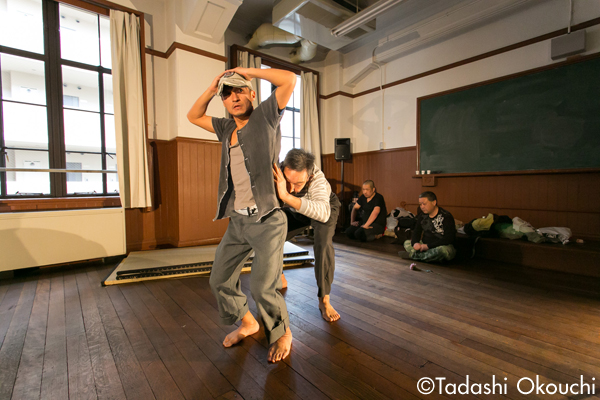
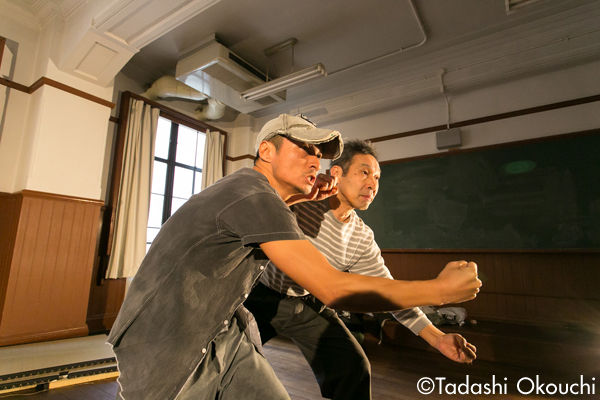
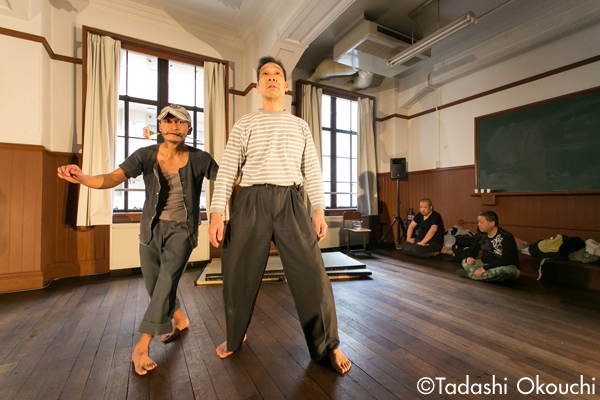
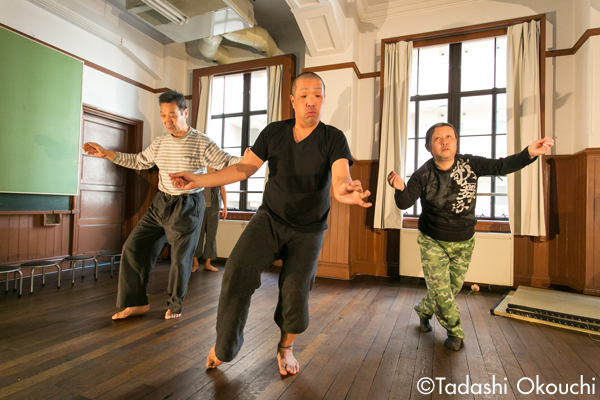
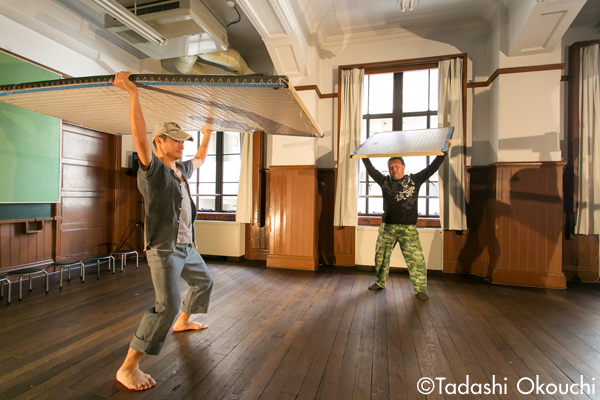
Shinjin H Sokerissa!
Shinsekai Waltz
(New world waltz)
(Community Dance Festival “Dance 4 All 2013”, Feb. 22 – 23, 2014 at Kyot Arts Center)
Photos: Tadashi Okouchi
Related Tags
Yuki Aoki
A homeless dance group Showing the living body
April 25, 2014
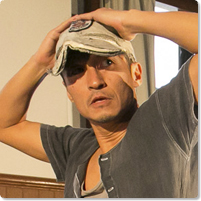
Yuki Aoki
The dancer and choreographer Yuki Aoki works with the homeless to create performances under the group name “Shinjin H Sokerissa!” The performances created with middle-aged homeless men who initially had no previous experience or interest in dance that Aoki approaches and encourages to turn attention to their bodies that have endured the struggle to stay alive, succeed in capturing audiences with the powerful presence of those bodies and an intriguing sense of humor.
Interviewer: Takao Norikoshi [dance critic]

